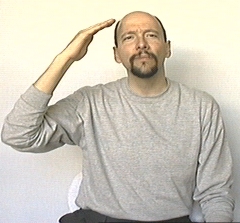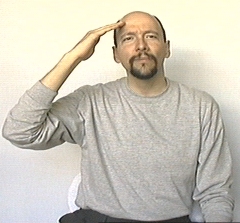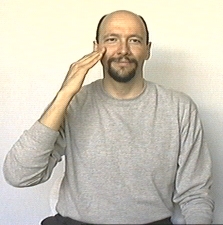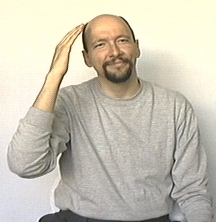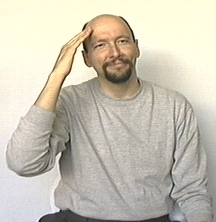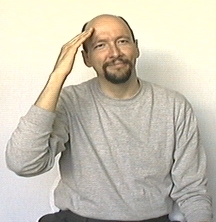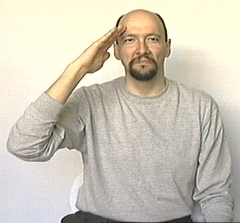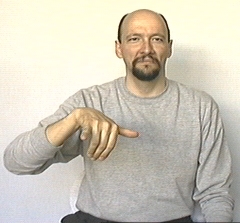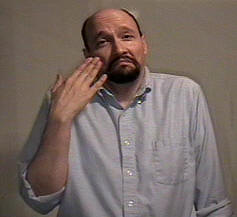American Sign Language: "know"
The sign for "know" touches the side of your forehead with the tips of the fingers of your hand in a flat shape.
KNOW:
Sample sentence: Do you know the teacher's wife's name?
It is very common for the sign for "KNOW" to be done on the cheek. Some people call it "lazy" signing.
I think a better word for it would be efficient signing. It is a perfectly fine way to sign the concept.
KNOW: (casual version)
If you want to sign, "knowledge," "familiar," or "I'm aware of that" you use a double movement. Touch the forehead twice.
FAMILIAR-with:
To sign "know that" you use a very quick downward movement and change the handshape into a loose "Y."
KNOW-THAT
The sign "don't know" uses a movement similar to "know that." The difference is that DON'T KNOW keeps the "B" (or "flat") handshape and tends to raise the shoulders and use a head shake. Here I'm showing a "casual" version of the sign. Note how it starts on or near the cheek (instead of the forehead) and twists forward.
DON'T KNOW:
If you have Windows media player, you might be able to view this .wmv file: DON'T KNOW
Notes and Optional Reading:
In a message dated 2/21/____ 12:13:53 PM Pacific Standard Time, my3boyzzz@_____ writes:My name is Leann and I have always been interested is sign language. my current mission is trying to learn and teach to my boys too. I do have a bit of help from a deaf family that I know and library books are good too. My 4 year old loves signing and I want him to learn all he can and we are teaching the baby too. Being able to communicate within the deaf community is a wonderful feeling. They are so patient with us when we try to sign. I am still a bit slow but will get it in due time with practice everyday.
Could you possibly explain how to sign " I don't know" like when my son asks me something and I need to sign to him I don't know. I have seen it done a couple of ways and was wondering what is actually used in the Deaf community. I have seen it done by the thumb of the "a" hand flicking out from under the chin and the other way is the "I" sign up against your chest and then you touch the tip of your fingers to your forehead, then move your hand outward.....not sure if I explained that very well. my friend that I was talking about earlier said the forehead one is like the slang version of 'I do not know'. Curious what your thoughts might be on this. I like to compare as many resources as I can to be more accurate.
thank you
Leann
Dear Leann,
See: http://www.lifeprint.com/asl101/pages-signs/k/know.htm
Scroll down to the bottom where you will see the sign "don't know."
A few notes: The sign you are referring to that uses the thumb under the chin can be interpreted as "not."
The sign that touches the tips of the fingers to the forehead can be interpreted as "know."
ASL grammar allows certain signs such as LIKE, WANT, and KNOW to incorporate a principle called "reversal of orientation for negation."
Additionally, the sign for KNOW is often done on the cheek rather than the forehead. Signs tend to evolve into more simple, arbitrary forms and doing the sign KNOW on the cheek instead of the forehead is a a way to reduce the overal movement of the sign thus making it simpler to produce.
The letter "I" held to your chest is a "Signed English" version of that concept. In ASL we tend to simply point at our chest to me either "I" or "me." Often the sign "I / me" is not necessary since the concept can be incorporated into the starting or ending location of other signs, (e.g. "GIVE-me").
If my child were to ask me a question to which I didn't know the answer I would simply sign "don't-KNOW" using the version of the sign KNOW that touches the cheek and twists outward. There would be no need for me to sign "I / me" because obviously I'm speaking about myself. There would be no need to use the sign NOT because the reversal of the orientation of the sign KNOW would inflect the sign to mean "don't know."
- Dr. Bill
Also see: don't-KNOW
You can learn
sign language
(ASL) online at American Sign Language University ™
Lifeprint.com © Dr. William Vicars
